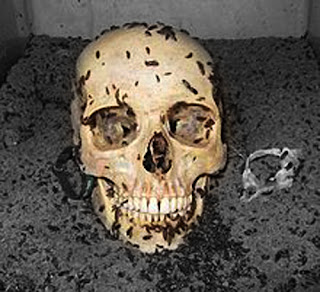
The act of depriving or divesting of flesh; excarnification; - opposed to
incarnation.
Easy ways to remove flesh from bone:
Bone cleaning can be done in a number of different ways;
* Soak overnight in bleach (bones will smell like bleach for some time
afterwards).
*Pour hydrogen peroxide over the bones and watch it foam. Continue to pour until
foaming ceases.
*Boil in water for between 15 minutes and half an hour.
*The natural method: place in a safe area outside (safe from wandering domestic
and wild animals) where ants or other carrion-eating insects can reach the
bones. A glass jar with large holes in the lid is recommended. Let the insects
clean the bones for you. This is a time-consuming yet very effective
method.
* A modification of the above (fourth) method: You might be able to
find information on ordering special beetles to clean the bones. I don't really
know anything about them, but, there are supposed to be beetles that eat flesh
off any sort of skeleton that are used within the medical/taxidermy professions.
Supposedly, that's how anatomical human and animal skeletons are cleaned.
* Boiling the bones in something called "sal soda". It dissolves tissue and cartiliage into a gel that can be rinsed
off.
*Or simply bury the specimen for a few months.
After doing any of these methods, you may have to remove extra "shreds" of
flesh. Try a combination of the above methods, bleaching the
bones overnight, then boiling them in sal soda for about twenty minutes was the
best method to get clean, white bones. If you overboil the bones, they will dry
out, and the outer calcium covering will flake away. They are still usuable if
this occurs.
Sal soda is sodium carbonate, the same chemical as washing soda. Sodium
carbonate typically comes in three forms - washing soda is the decahydrate,
which is usually in the form of colourless crystals that look a bit like crushed
ice. If left in the open air, these lose water and become the powdery white
monohydrate (the sal soda mentioned above). Soda ash is the anhydrous
compound.
|
|

Dermestidae
Dermestidae are a family of Cleopatra that are commonly referred to as skin beetles. Other common names include larder beetle, hide or leather beetles, carpet beetles, and khapra beetles. There are approximately 500 to 700 species worldwide
These beetles are significant in forensic entomology. Some species are known to be associated with decaying carcasses which help with criminal investigations. Some species are pests (urban entomology) and can cause extensive damage to natural fibers in homes and businesses.
They are used in taxidermy and by natural history museums to clean animal skeletons. Some dermestid species, commonly called "bow bugs," infest violin cases, feeding on the bow hair.




Sem comentários:
Enviar um comentário